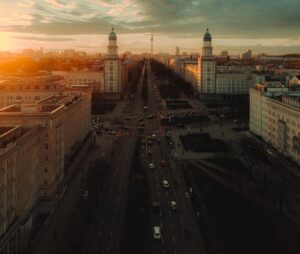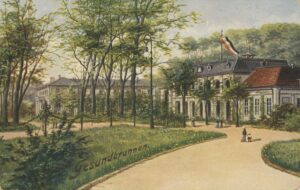The old Imperial Capital of the Empire, the Reichshauptstadt Berlin, became a true Welt Stadt, or World City by the 1920s, and what made this possible, in the most literal sense of the word, was the development and expansion of the public transport system. If you really want to understand Berlin, you have to ride the rails.
Understanding Berlin’s History Through Its S and U-Bahn Lines
For this installment, rather than give you a potted history of the S and U-Bahn train lines, I thought I’d offer an interesting suggestion or two, in order to help you see the history and the culture of the World City through the lens of the train lines. It’s one of my favorite ways to learn about a city, and I encourage you to ditch the car and head to the trains.
Connecting with Berlin’s Past Through Public Transport
The first point to make is that when you ride the rails in any old European city, you’re experiencing something that generations of people have experienced as well. Sure, the trains are becoming more advanced and sophisticated and the paraphernalia associated with the stations reflects our tastes and expectations, from modern advertisements to digital arrival and departure boards. But despite all that, when you ride on Berlin’s trains, you’re following the same routes to the same destinations as those who lived in the Kaiser’s empire, those who lived under Hitler and in the divided city of the Cold War. It’s a wonderful and subtle way of connecting with the people who were here before us and getting a small taste of their daily lives.
Exploring Berlin’s Train Stations: A Living Panorama of History
Once you exit the trains and look around at the stations you’ll begin to see the panorama of Berlin’s story displayed in front of you. Here is one of the more interesting things you’ll see, and you’ll need Google maps open to get the immediate effect.
Tracing Berlin’s Lost Train Stations
Back in the city’s imperial days, Berlin played host to a number of mainline overland train stations (or «bahnhof») which led off from all points of the compass across Germany and Europe. These great stations were all either destroyed in the war, or closed down after the start of the Cold War and never rebuilt, or were rebuilt underground after the Wall fell. Once mighty terminals like Anhalterbahnhof – once Europe’s largest and busiest station – now exist only in memory. Of Anhalter, all you can see today is a part of the front entry hall’s wall. Potsdammerbahnhof has been rebuilt underground. Gorlitzer Bahnhof has vanished completely, as has Stettin Station. Lehrterbahnhof has been wiped off the face of the earth only to be resurrected in a completely new guise in 2006 as Berlin’s Hauptbahnhof, or Main Train Station. Only Silesian Station, now Ostbahnhof, can lay claim to continued existence, although much altered and rebuilt over the years.
Ghost Stations: Echoes of Berlin’s Past
Yet you can still find ghostly echoes of these once pulsating centers of urban power. Stettin Station was renamed Nordbahnhof after the war before being shut down and leveled, due to its laying across the path of the Wall. But the S-Bahn station that once served the overland line still exists as Nordbanhof and today provides access to the Berlin Wall memorial and has a nice exhibit in the vestibule about the so-called Ghost Stations, a phenomenon dating from the division of the city in the Cold War. But if you walk around the outside entrance to Nordbahnhof, away from the Wall memorial, you’ll find markers in the road showing where the rails to the vanished terminal once ran, and the names of the destinations the station once serviced. It’s a little recognized memorial, but startling once you see it and realize how dramatically the area has changed.
Anhalterbahnhof: A Station Lost in Time
Similarly, the S-Bahn still has a station named Anhalterbahnhof, despite that mainline station’s decades long non-existence. Exit there, and you’ll find a forlorn wall from the station’s heyday still standing, reminding us where the terminal once stood. Nearby you’ll find an overland bunker from the war, with an interesting exhibit on the rise of the Nazi party inside.
Urban Archaeology: Mapping Berlin’s Lost Train Stations
Apart from this, you’ll be able to track where the old stations once stood by taking a look at your Google maps. Find the stations that bear the names of the old imperial stations. Look around nearby on your map and you’ll find a rectangular parcel of land. These are usually parks now. These mark the locations of the old passenger stations and the nearby heavy good’s stations. It’s urban archaeology at its best and is a fun and fascinating way to explore the city and dig into its past. The only exception to this rule is Lehterbahnhof, today’s Hauptbanhof, as the former station has been totally built over and is unrecognizable even in ghostly form today.
Berlin’s Oldest U-Bahn Lines
When you’ve done that, you can ride the U1 or U3 lines, thereby getting onto the oldest section of the network. This is a good place to uncover another epoch of the city’s history, namely the locations of some of the gates in the 18th century walls. The German word Tor means gate, and you’ll find a few stations on these lines with that word. The reason is simple. The train stations were built on the sites of the those long-outdated gates. Brandenburger Tor is the only surviving gate, of course, but to see where the others stood, stop at places like Schlesisches Tor or Silesian Gate, so named as it marked the start of the road that led to Silesia, now in Poland. A bit further down and you’ll come across Kottbusser Tor which marked the gate guarding the road to the town of Kottbus and Hallesches Tor, whose gate marked the start of the road to Halle. While you’re here, by sure to get off to explore the area, as these places today mark access points to Kreutzburg and play host to a vibrant Middle East scene with some great local restaurants and cafes. This is also the modern city’s «edgy» areas, so if you want to get a feel for what animates Berlin’s social scene, this is a must-see area.
Friedrichstrasse Station: A Cold War Relic
Finally, and a bit more on-the-beaten track, be sure to visit Friedrickstrasse station, once host to East Berlin’s Cold War era international border crossing. Here you’ll find the Palace of Tears, the entry point for westerners to leave the DDR – and in many cases their Eastern family and friends – behind as they returned to West Berlin. Today there is a great exhibit in the building about the process of crossing the border here. The guts of the stations itself have been gutted and rebuilt, but back in the day, this was a hotbed of espionage and political tension. All that is gone now, but its worth poking around the station and seeing what little mysteries and memorials you can uncover. There are certainly a few. Historically speaking, Friedrickstrasse is probably Berlin’s most historically important train station.
Berlin by Train: A Journey Through Time
Exploring Berlin by using it’s interconnected train networks is a wonderful way to get to know the city deep down, picking up famous and not-so-famous sites, all of which will enhance your enjoyment of the city and its history. Happy travels!





